Claimants … in brief
July 2025
Key Findings:
- Claimant Count (people seeking work): There were 11,330 unemployed claimants of Job Seekers Allowance (JSA) and Universal Credit (UC – searching for work conditionality) in June 2025 (3.6% of working age people).
- Unemployed UC/JSA claimant numbers increased by 2.6% (285 claimants) in the year from June 2024 and increased by 2.4% (up 265 claimants) in the month to June 2025. The claimant rate in East Sussex (3.6%) remains lower than national (England) figure of 4.2%.
- Universal Credit (people on low incomes): There were 59,451 people claiming any UC in June 2025 (18.3% of people aged 16-65), of whom 48,609 are not included in the Claimant Count above (i.e. not ‘Searching for work’ conditionality).
- The number of UC claimants has seen an annual rise of 14.5% since June 2024. This is an increase of 7,618 claimants.
- Note that the DWP have now released the delayed UC data for April and May 2025.
In East Sussex, overall unemployed claimant numbers have risen by 2.6% over the past year, from 11,045 in June 2024 to 11,330 in June 2025. This compares to England, where the annual increase in claimant numbers was 6.9%.
There were 3.6% of working age people in East Sussex claiming UC/JSA in June 2025, lower than England rate (4.2%), but higher than the South East region (3.2%).
Claimant rates, England, South East, East Sussex and districts, June 2024 and June 2025

Youth unemployment has started to fall
Youth unemployment saw a slight increase in the year to June 2025. The number of UC/JSA claimants aged 18-24 in East Sussex rose from 1,955 in June 2024 to 2,020 in June 2025, an increase of 3.3%. This is significantly lower than the national rise of 10.7% among young claimants over the same period. However, the number of young claimants has been falling since February 2025 (see chart below), when there were 2,135 claimants in the county.
6.0% of people aged 18-24 in East Sussex are now claiming UC/JSA (June 2025), with numbers down by 1.0% (20 claimants) in the month since May 2025. The number of young male claimants by rose by 6.6% in the year, from 1,215 in June 2024 to 1,295 in June 2025. But young female claimants declined by 2.7% over the year from 745 to 725 in June 2025. The claimant rate among young men at 7.4% is considerably higher than young females (4.5%).
The highest levels of youth claiming are seen in Hastings, where 8.8% of young people are claiming UC/JSA, including 11.0% of young males in June 2025. But the number of young claimants in Hastings have been declining quickly and there were 8.8% fewer young claimants in June 2025 (520) than in June 2024 (570). In Eastbourne, however, youth claiming is rising fast – there 23% young claimants in June 2025 (525) than in June 2024 (435), and there are now 7.4% of young people claiming in the borough, and 9.5% of young males aged 18-24.
Claimant rates by age group, East Sussex June 2022-2025
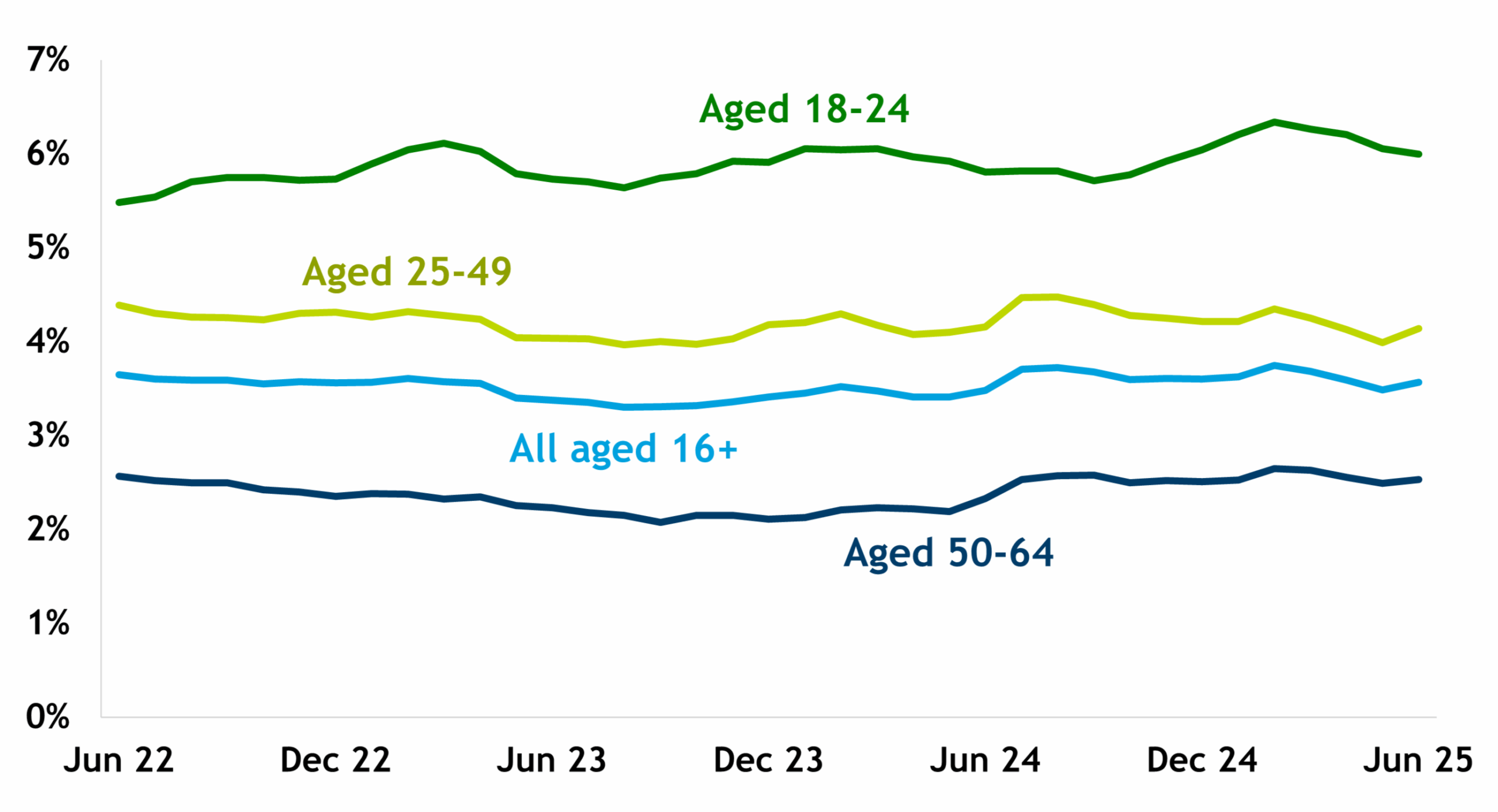
Number of unemployed claimants of UC/JSA
| June 2024 | June 2025 | Actual change | Annual % change | |
| Eastbourne | 2,540 | 2,935 | 395 | 15.6% |
| Hastings | 2,930 | 2,735 | -195 | -6.7% |
| Lewes | 1,890 | 1,950 | 60 | 3.2% |
| Rother | 1,590 | 1,600 | 10 | 0.6% |
| Wealden | 2,095 | 2,110 | 15 | 0.7% |
| East Sussex | 11,045 | 11,330 | 285 | 2.6% |
| South East | 172,520 | 185,675 | 13,155 | 7.6% |
| England | 1,429,560 | 1,527,980 | 98,420 | 6.9% |
Percentage of working age people claiming UC/JSA because of unemployment
| June 23 | June 24 | June 25 | |
| Eastbourne | 4.4% | 4.2% | 4.8% |
| Hastings | 5.3% | 5.2% | 4.9% |
| Lewes | 2.9% | 3.3% | 3.4% |
| Rother | 3.2% | 3.2% | 3.2% |
| Wealden | 2.0% | 2.3% | 2.3% |
| East Sussex | 3.4% | 3.5% | 3.6% |
| South East | 2.8% | 3.0% | 3.2% |
| England | 3.7% | 3.9% | 4.2% |
Claimant rate by ward in June 2025
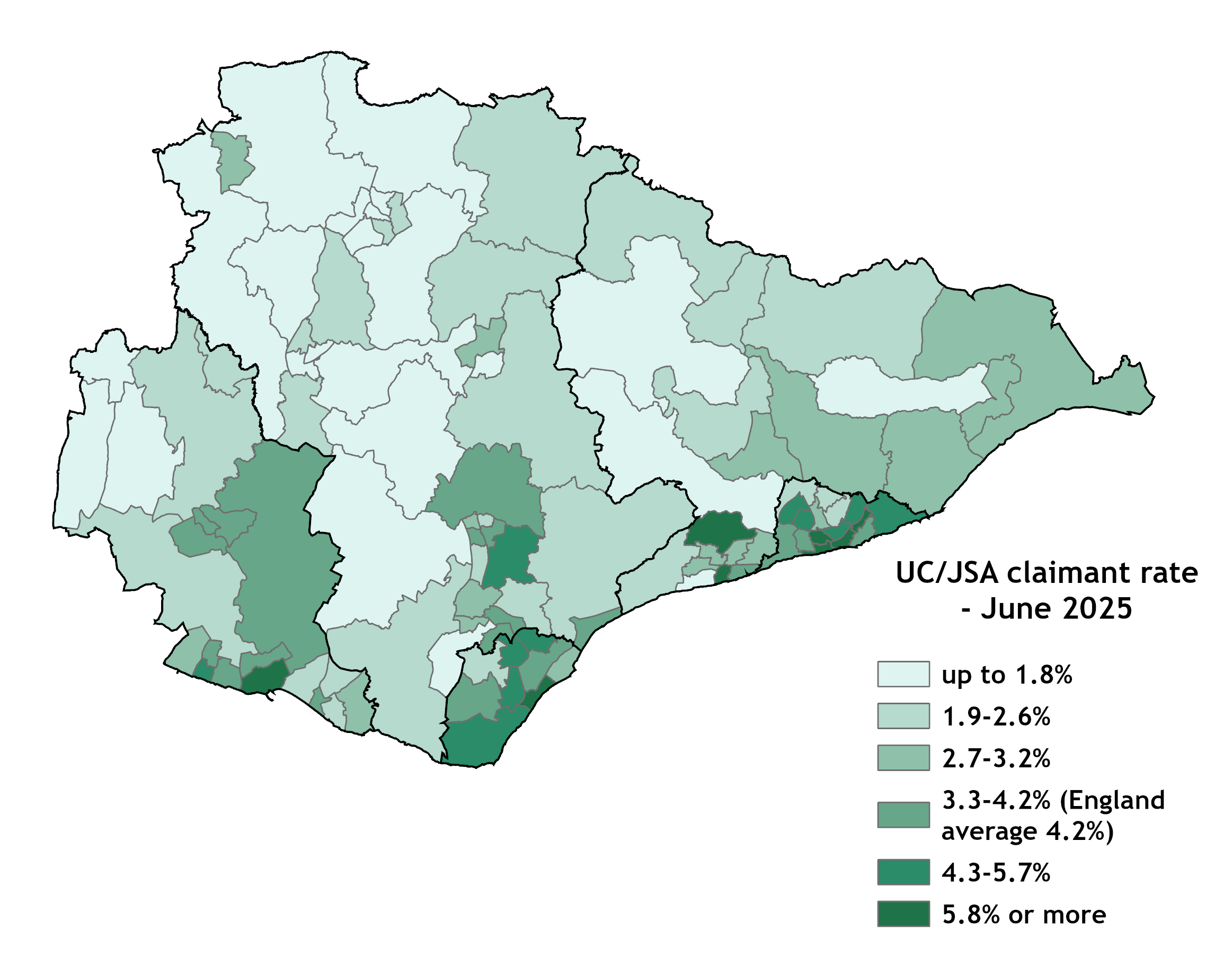
Wards
In June 2025, 20 East Sussex wards had rates at or above the England average (4.2%), with the highest rates in Devonshire (9.2%) in Eastbourne, and Central St Leonards (7.4%), Castle (7.3%) and Gensing (7.1%) in Hastings.
This includes 9 wards in Hastings, 5 in Eastbourne, 3 in Lewes, 2 in Rother and 1 in Wealden
44 wards saw an increase in claimant numbers in the month to June 2025, while 23 wards saw a decline.
Claimant rate at ward level in ESiF Data explorer
Districts
Claimant counts rose in all districts in June 2025 with the lowest rises in Hastings and Lewes (both up 15) a rise of 35 in Rother and the largest increases in Eastbourne (up 105) and Wealden (up 20).
However, while Eastbourne saw a significant annual increase in claimant numbers over the year (up 395 or 15.6%), in other districts the annual rises were more modest (Lewes up 3.2%, little change in Rother and Wealden), and in Hastings there was a decline of 195 claimant, or 6.7%. This compares to a rise in England of 6.9% and in the South East region of 7.6%.
In June 2025 Hastings had the highest claimant rate in the county with 4.9% of working age people claiming UC/JSA because of unemployment. The rate is now only just higher than Eastbourne at 4.8% of the working age population, compared to 4.2% nationally.
In June 2025, despite a declining rate, Hastings still has the third highest claimant rate in the South East region, behind Slough (6.6%) and Thanet (5.3%). Eastbourne has the joint fourth highest claimant rate (4.8% – with Portsmouth and Crawley) in the region.
Universal Credit Claimants
In East Sussex in June 2025 there were 59,451 people claiming UC (18.3% of working age people). This was an increase 1,271 since May 2025 (up 2.2%) and up 7,618 (14.5%) since June 2024. In May 2025, 34.9% of all UC claimants were in employment (measured by employment indicator – data not yet available for June).
Note that one of the reasons that the number of Universal Credit (UC) claimants is rising is because of the migration of claimants of other benefits such as Tax Credits, Employment and Support Allowance and Housing benefit, into the UC regime. This migration is being rolled out more assertively this year.
UC claimant numbers and rates in June 2025
| Number of UC claimants in June 2025 | % of age 16-65 claiming UC in June 2025 | |
| Eastbourne | 13,901 | 22.3% |
| Hastings | 15,121 | 26.6% |
| Lewes | 9,858 | 16.8% |
| Rother | 9,243 | 17.9% |
| Wealden | 11,328 | 11.9% |
| East Sussex | 59,451 | 18.3% |
Change in number of UC claimants
| Change in UC numbers June 2024-25 |
% change in UC numbers June 2024-25 |
Change in UC May 2025-June 2025 | % change May 2025-June 2025 |
|
| Eastbourne | 1,911 | 15.8% | 346 | 2.6% |
| Hastings | 1,800 | 13.5% | 312 | 2.1% |
| Lewes | 1,405 | 16.4% | 180 | 1.9% |
| Rother | 1,123 | 13.6% | 202 | 2.2% |
| Wealden | 1,383 | 13.7% | 232 | 2.1% |
| East Sussex | 7,618 | 14.5% | 1,271 | 2.2% |
Number of Universal Credit claimants by conditionality, June 2022-2025
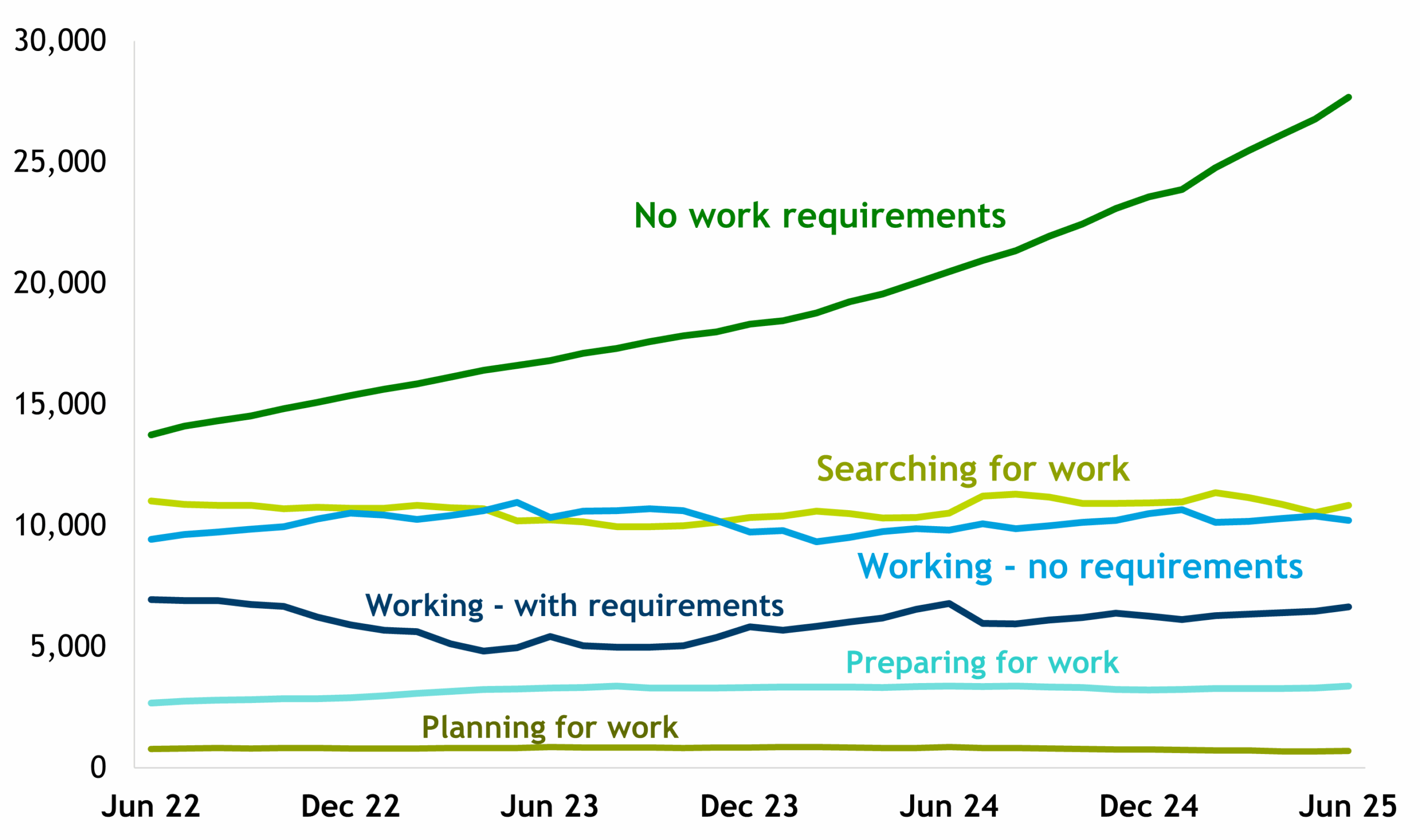
In the year to June 2025 there was an increase among most conditionality groups except those in the ‘Planning for work’ (down 18.2%) and ‘Working with requirements’ (down 2.0%) groups. The conditionality group seeing the largest rise was the ‘No work requirements’ group, with 7,202 more claimants (up 35.2%). Many people in this group will be claiming because of ill health (see paragraph on health claimants below for more information). There was also an increase in the ‘Working – no requirements’ group (up 3.9% or 388 claimants) but no real change among the ‘Preparing for work’ group (4 more claimants).
While the number of male unemployed UC/JSA claimants is higher than the number of female claimants (see dark green: male and dark blue: female lines, labelled ‘Claimant count’, in the chart below), the number of female claimants in all UC conditionality groups (light blue line) is much higher than the number of males (light green line) claiming. UC claimant numbers of both sexes continue to rise.
Male and female claimants of Universal Credit and UC/JSA unemployed claimant count, June 2019 – June 2025, East Sussex
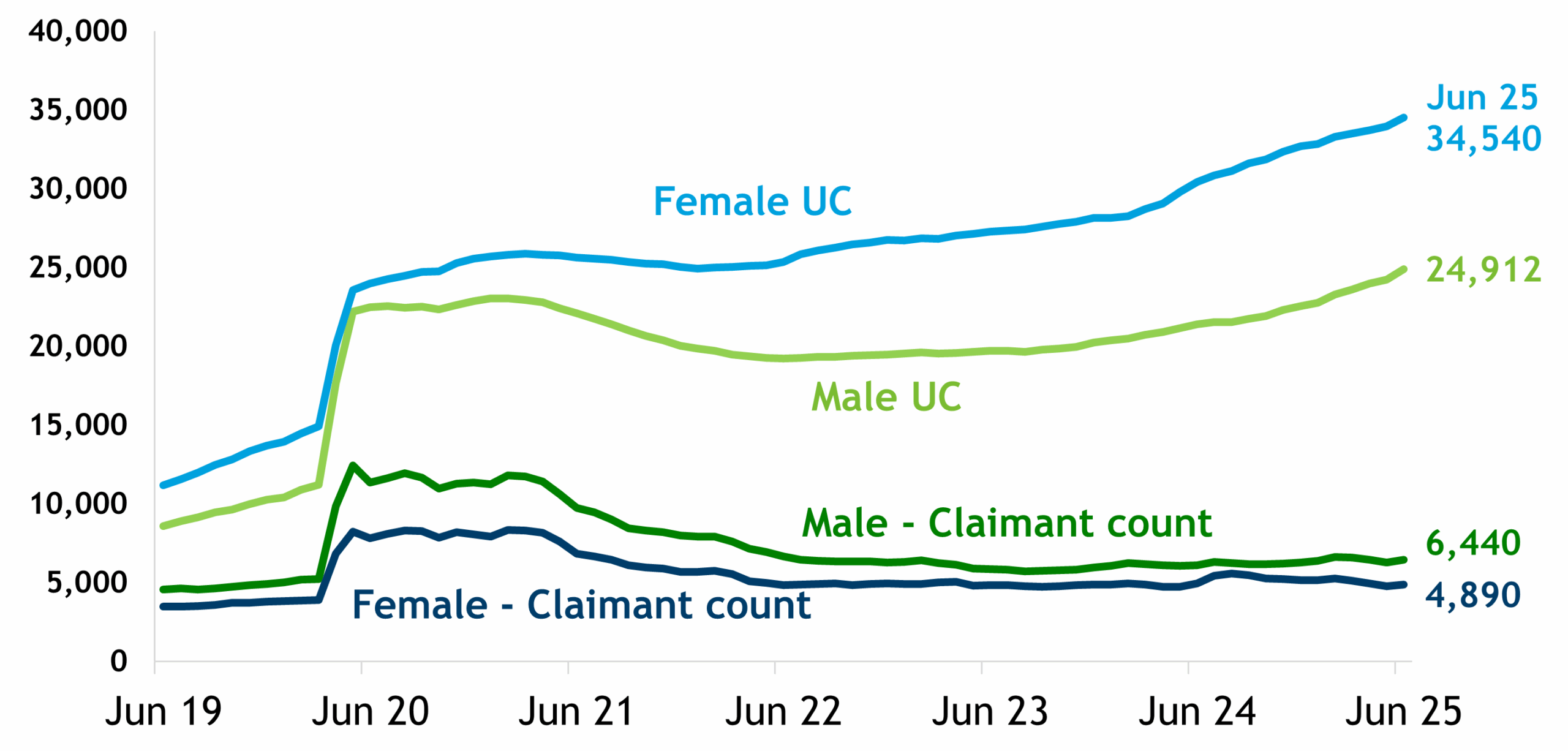
Universal Credit Health caseload
In March 2025, there were 57,128 people claiming Universal Credit (UC) in East Sussex, and of these 36.4% (20,799 claimants) were receiving UC because they had a health condition or disability restricting their ability to work. While the overall number of UC claimants rose by 15.5% in the year to March 2025, the number of claimants who were receiving UC because of a health problem increased by 24.7% over the year.
Although a higher number of women are claiming UC than men, 40.1% of male UC claimants in March 2025 were claiming for health reasons, compared to 33.8% of female claimants.
Total UC claimants by health journey and sex, March 2024 and March 2025
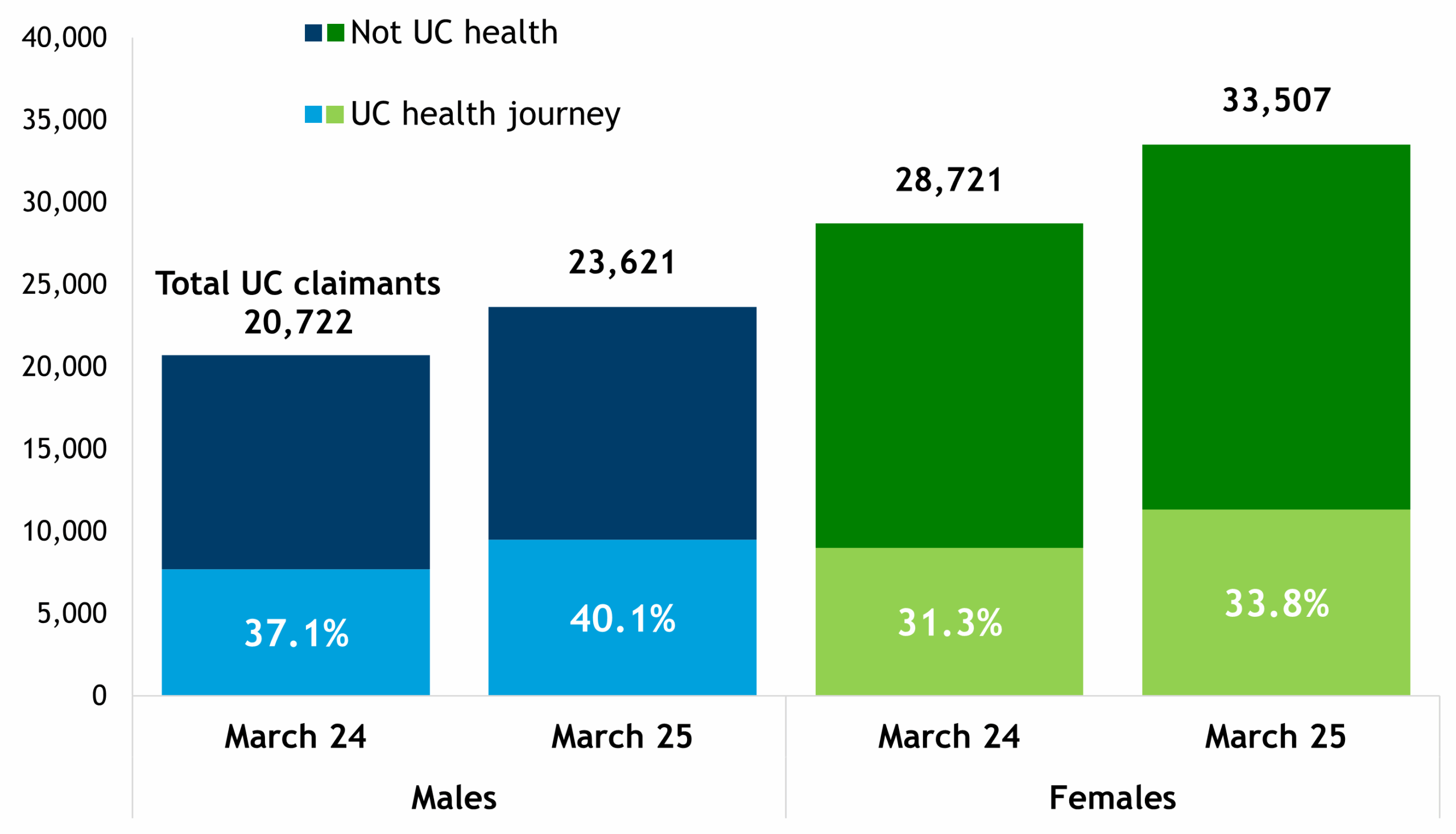
Further information
The Claimant Count measures the number of people who have made claims for benefits for reasons of unemployment. Most new claimants for benefit receive Universal Credit, but there are some claimants who do not qualify for UC because they have savings of over £16,000, who may be entitled to contributions-based JSA, which is not means-tested.
The main Claimant Count, which includes all JSA claimants and all UC claimants in the ‘searching for work’ conditionality group, gives an up-to-date measure of changes to the number of unemployed claimants. A small number of UC claimants may subsequently be reallocated to other conditionality groups.
To qualify for JSA or UC as a job seeker, claimants must meet certain eligibility criteria which include being available for, and actively seeking, work. Some claimants might do some work (less than 16 hours per week) and still be eligible if their earnings are very low, as long as they continue to meet all the UC work-seeking requirements. JSA claimants include those claiming only National Insurance credits.
The Claimant rate is defined as the number of claimants resident in an area expressed as a percentage of the working age population, which includes all people aged 16-64. Rates for other age groups use the population of that age group. Population figures are derived from the latest Office for National Statistics (ONS) mid-year population estimates.
The Claimant Count is often used as an indicative measure of unemployment as it provides frequently updated information for a range of geographies. Care should be taken not to confuse this with ONS official labour market statistics which use the International Labour Organisation’s definition of the unemployment rate, which includes all those aged 16 plus who are out of work, but actively seeking work, including those claiming no benefits, as a percentage of all Economically Active people aged 16 and over. These are based on the Labour Force Survey and Annual Population Survey, which is less statistically robust at county and district level.
Links to other useful resources
Contact details
For further information about unemployment, benefits, claimants and other labour market data please contact esif@eastsussex.gov.uk.
